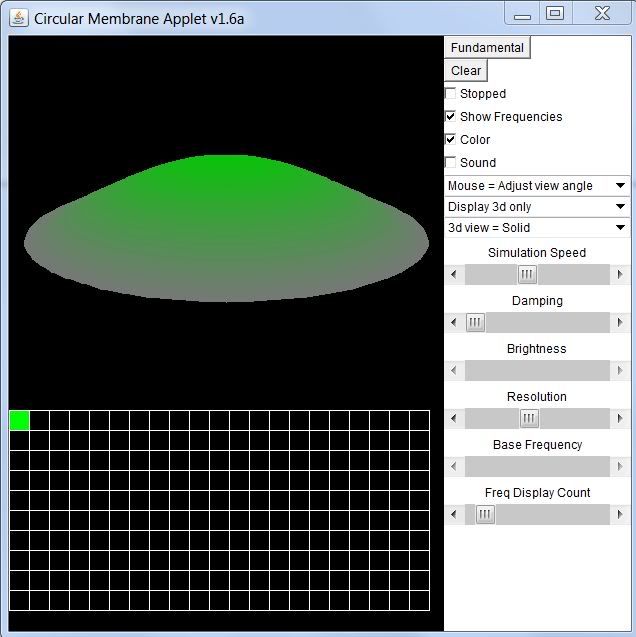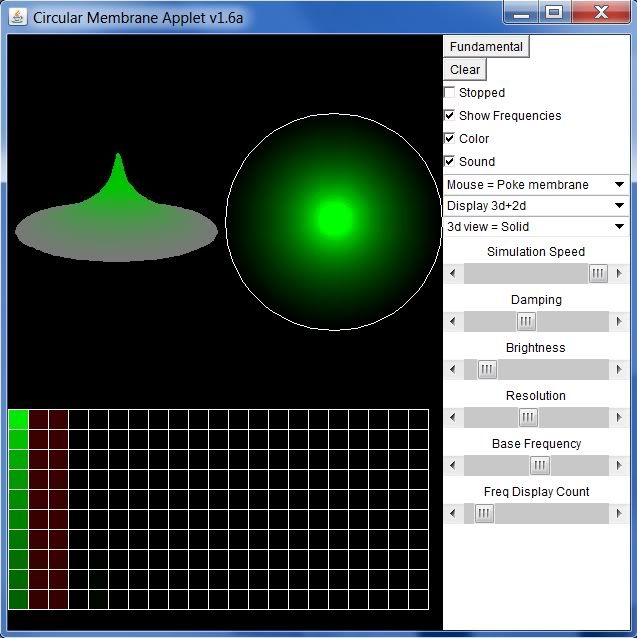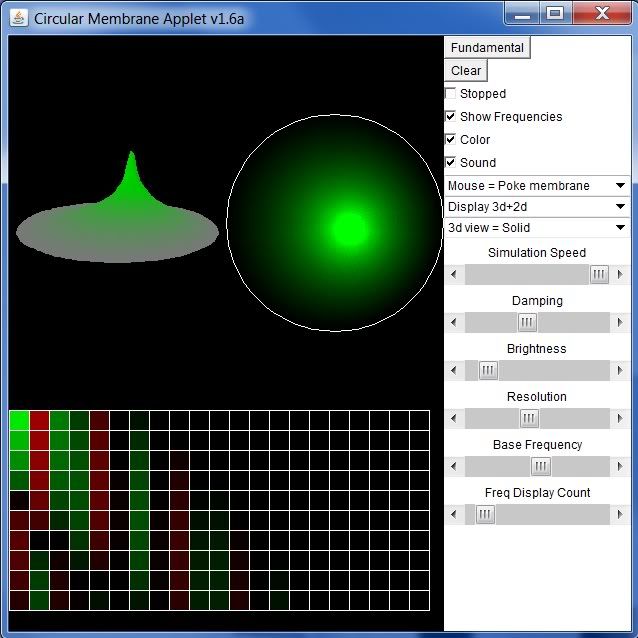Drum Head Vibrations
submitted by Derrick Knight (knight427)
Every drummer knows that hitting a drum directly in the center gives a much different sound than hitting a drum off-center. This difference in sound quality is most extreme on large drums such as timpani. While a technical understanding of wave mechanics is not necessary to play a drum properly, it is helpful to understand the basics of how your drum is producing the sounds you hear.
Ideal Case Study: circular membrane modal behaviorA drum head is a circular membrane. While most drums have both a top and bottom head, it is really only necessary to consider the top head to achieve a sufficient level of understanding for our purposes. Below you will see a high-speed video of a circular membrane undergoing sympathetic vibration with the subwoofer shown in the same shot. While the video is slowed down to show the motion, the audio is dubbed over at normal sped so you can hear the actual tones being produced by the speaker. The first one is approximately 82 Hz, which means in reality, both the speaker and membrane are completing an up-down (or in-out) motion 82 times per second.
In the first shot, you are seeing the membrane vibrate at its fundamental mode. This is the slowest vibration the membrane can sustain, which means it is the lowest pitch produced (by the head) when you strike it. This pitch is primarily determined by the diameter of the membrane and the tension. This mode can only be started if the speaker is producing 82 Hz. It does not matter if the speaker also produces 41 Hz (an octave below) or some other random frequency, only the 82 Hz tone within whatever sound is produced by the speaker will be driving this mode. This may sound obvious at this point, but it will be important later on to understand that a mode can only be excited by a driving force which contains the modal frequency.
Now note the mode shapes in the video above. The fundamental of any system with fixed endpoints will cause the entire system to move in unison. This will make more sense when you reach 0:23 in the video when the pitch changes to 158 Hz. In this mode, you can see that the membrane is essentially split in half and those 2 halves move in opposition to one another. At about 0:48 you will see 217 Hz which cuts the membrane into quarters. At 1:06 the pitch goes up to 227 Hz and the motion changes dramatically. This mode is actually closely related to the fundamental. It is circular mode just like the fundamental. This is another detail that will be important later, we will explore this a bit more than you may think is necessary at this time.
NodesA node is place of no motion. The fundamental mode of a membrane has a node along the entire perimeter (rim). In fact, every single mode of the membrane will have this circular node since the rim prevents the membrane from moving here. This is the only node of the fundamental mode, and its shape is a circle, so it considered a circular mode.
 fundamental mode (circular)
fundamental mode (circular)
The mode viewed at 0:23 has another node running down the middle of the membrane (no motion along this node line), this mode has one circular node (rim) and one linear node (so it is NOT a circular mode).
 (1,1) mode
(1,1) mode
At 0:48 you see another non-circular mode with two nodal lines cutting the head into quarters (again, no motion at the nodes).
 (2,1) mode
(2,1) mode
At 1:06 we see another circular mode because both nodes are circles (one at the rim, the other half way into the circle).
 (0,2) mode (circular)
(0,2) mode (circular)
The really important idea here is to see that circular modes will always have motion in the center of the membrane, while non-circular modes always have one or more nodal lines running through the center point.
Animations courtesy of Dr. Dan Russell, Kettering University
Striking a Circular MembraneNow that we have a basic understanding of modes and nodes, we can move along to a more detailed investigation of circular membrane modes. Specifically, what happens when we strike the circular membrane at different locations.
First I will point out the obvious. Striking a drum head with a stick is very different from exciting modes of vibration with a pure tone produced by a speaker. The first difference is that when you strike the head, you almost create an impulse. An impulse has a very specific definition in acoustics, but basically it is a very short pulse with large amplitude that contains all frequencies. As mentioned above, in order to excite a particular mode, it must be driven by a signal that contains the specific modal frequency. We are in luck here then because an impulse contains all frequencies, so all modes are capable of being excited by a single down stroke. We don’t have to tune our drum stick or time our pulses. Second, I will remind you that all modes have nodes (locations of no motion). If you strike a node, you cannot excite the mode which contains that node. Remember that all non-circular modes have one or more nodal lines running through the center of the drum.
Putting this information together, we can start to understand what really happens when we strike the middle of the drum head. Your impulse is capable of exciting all possible modes supported by the head. But if you hit it dead-center, none of the non-circular modes will be excited, thus producing far fewer frequencies. But if you move slightly off-center, no important nodal lines run through that location and you can excite most of the modes and thus produce more frequencies.
Try playing around with this application. When you click on the link, the app should open in a new window and look like this:

The boxes on the lower half indicate modes. The fundamental mode is on by default and you see a familiar mode shape on the membrane. You can click the boxes to turn modes on and off. You should be able to find the previous modes listed and many more (only turning one box a time will make them easier to see).
Now adjust a few settings. Click the sound box and you hear a simulation of the membrane sound (keep in mind this is a simple model and it will not really sound much like a real drum). Change the drop-down menus to: Mouse = Poke membrane Display 2D+3D
Now you can tap the membrane in different location, hear a simulation of the sound, and see which modes are excited. The picture below shows a tap near the center. Note that only a few of the modes are excited. If you already played around with the modes, you might also notice all of the modes in the first column are circular modes.

Now tap off-center and note how many more modes are excited. Now you have many circular and non-circular modes going, giving you a more complex sound (more frequencies).

Playing a Real Drum
Finally we can check to see that all these simulations relate to a real drum with 2 heads and a shell (which complicates things considerably). Watch this high-speed video of an actual drum head being played. If you watch it straight through, it is difficult to discern much relevant information. However, if you repeatedly watch the first strike at 0:01, you can see the stick strikes the head nearly in the middle of a quadrant and primarily excites the (2,1) mode (see .gif animations above). At 0:12, in the lower frame the stick strikes pretty close to the center, and you mostly see the fundamental. Finally, the last strike at 1:02 hits just off-center and you can see both circular and non-circular modes being excited.
Conclusion
When a drum head is played in the center, only a small portion of the modes are excited. Specifically, only the circular modes will be excited because all of the non-circular modes have nodes in the center. Therefore only a small portion of the frequencies are produced, and the drum sounds “dead”. By striking the drum head off center, most of the modes can be excited and we can hear the full timbre of the drum.


